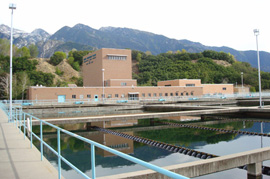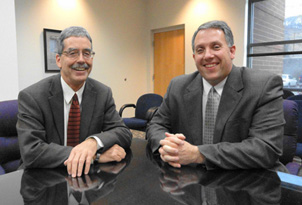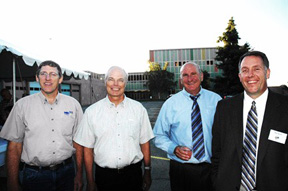The Metropolitan Water District of Salt Lake & Sandy Celebrates its 75th Anniversary
The district was created during the worst of times during the Great Depression and the worst drought of record.
LeRoy W. Hooton, Jr.
MWDSLS Little Cottonwood WTP treats water from multiple water sources for delivery to Salt Lake City and Sandy City.

November 23, 2010
On September 25, 1935, the Metropolitan Water District of Salt Lake City (MWDSLC) was formed to develop a long-term dependable water supply for Salt Lake City. In 1990, Sandy City was annexed into the district, changing its name to the Metropolitan Water District of Salt Lake & Sandy (MWDSLS). The annexation consolidated and made more efficient the delivery of water within the Salt Lake Valley.
On September 20 MWDSLS celebrated its 75th anniversary. Its role of providing safe drinking water supply to its customers has not changed over the years. “Then and now, as much change has occurred in the world in the last 75 years our mission is fundamentally the same today as it was then. We strive to provide high quality water, in timely and adequate amounts – at a low cost to the public, while preserving the environment that we live in,” said General Manager Michael L. Wilson on the day of celebration. The district held an open house and special events.
According to MWDSLS's Annual Report during the past 3-years it has delivered an average of nearly 48,000 acre-feet of water supply to the Salt Lake City Department of Public Utilities, which in turn distributed it to its retail customers within the City's service area. In total, during this same period MWDSLS wholesaled 70,000 acre-feet of water to all its customers. MWDSLS has 65 employees and a revenue stream in 2009 of $36.2 million, which includes revenues from water sales, property taxes and a special CIP assessment. It has total assets valued at over $425 million.
Public Utilities director Jeff Niermeyer, prizes the relationship between MWDSLS and the City's water utilities department. “We have had a long and beneficial relationship with Metro in developing a long term water supply for Salt Lake City,” said Niermeyer. Providing the public the highest level of service requires close coordination and cooperation between both of the two water entities. According to Niermeyer, both Public Utilities and MWDSLS's systems are integrated, with one depending on the other to deliver millions of gallons a day of water through a myriad of treatment plants, aqueducts, reservoirs, pumping stations and distribution mains. Niermeyer congratulated MWDSLS on its 75th anniversary, saying, “I'm looking forward to continuing our splendid relationship as we work together in meeting the challenges facing us into the future,”
|
The formation of the MWDSLS 75 years ago happened during a most challenging period. It was the worst of times: the nation was in the midst of the economically crippling Great Depression and a wide-spread drought that created the devastating Dust Bowl in the southern region of the Great Plains. Within the drought's area of influence were both the Great Basin and Upper Colorado River Basin, which produced the worst recorded drought in the Salt Lake Valley and greatly diminished the flows of the canyon streams and drained Utah Lake. Despite this adversity, City officials and citizens took action to develop a long-term water supply program.
The origin of MWDSLS began with the election of Mayor John F. Bowman in 1928. Under the Commission form of government, each elected official was assigned one city department. Mayor Bowman was assigned the Water Department. At this point in time the City had developed water resources from the local canyon streams, primarily through exchange agreements with the local farmers. Several small dams in Parley's and Big Cottonwood canyons provided limited water storage to meet summer peak demand and protection against droughts. As the City's population continued to grow, the need to expand the City's water resources became more critical.
Mayor Bowman was facing a daunting challenge. Aided by Water Superintendent H.K. Burton and City Engineer H.C. Jessen, Mayor Bowman, with the slogan, “A city can never be greater than its water supply,” undertook the challenge with determination. His first action was to form a Citizens Advisory Board (Board) in 1928 to study the matter and to make recommendations, which would lead to the acquisition of an adequate water supply for a minimum population of 400,000.
Within a year the Board made its recommendations, which included developing water resources from both within the Salt Lake Valley and importing water from the then proposed Deer Creek Reservoir, located on the Provo River. The Board noted in its report that among other reasons Deer Creek would supply water to Salt Lake City at less annual cost than any other supply studied and further insured an adequate supply of water for the indefinite future. (Note: In 1928, as now, Deer Creek Reservoir was part of the then proposed U.S Bureau of Reclamation constructed Provo River Project, which included Deer Creek dam forming a 150,000 acre-foot reservoir, trans-basin diversion works on the Weber and Duchesne rivers, a dike on Utah Lake, canal enlargements and other related lands, facilities and appurtenances.)
The City administration immediately began acting on the recommendations. Inasmuch as it would be at least a decade before Deer Creek Reservoir water would be available, the City moved forward to develop local water resources first. A $2 million bond was approved by an election on July 1, 1931 to finance local projects. As the 1930's drought deepened, the City continued to develop addition local resources by drilling deep wells, constructing the Little Cottonwood Conduit and purchasing the Artesian Basin near Murray, Utah and conveying this water through a pumping plant and pipeline to the City.
The City concurrently pursued acquiring water supply from the Provo River Project. The project would develop 100,000 acre-feet of agricultural and municipal water annually for use in Utah and Salt Lake Counties. However, after careful study, the City determined that it could not directly participate in the project. According to City Attorney Fisher Harris, “municipal corporations as such [were] precluded from participating in the project ...” In order to obviate the problem, it was decided in 1935 to enact state legislation to permit the City to join with others to build the Provo River Project. The Metropolitan Water Act allowed cities to create districts within their corporate boundaries for the purposes of developing water resources and facilities to meet their public water needs. The legislation granted these districts eminent domain and taxing powers with authority “to construct waterworks, reservoirs, power plants and other works and to do any and all things necessary for the carrying on the business of acquiring water, water rights and all properties necessary to conduct the business for which the district is organized.” At a special election held on August 15, 1935, voters approved the City forming such a district. On September 25, 1935, the District was formally established by the City Commission as the MWDSLC.
The first Board of Directors took office in October 1935. City Attorney, Fisher Harris, was appointed General Counsel of the newly formed district. Beginning in 1941, he held the positions of General Council and General Manager until 1963. Mayor Bowman's term in office ended in 1931. Mayor Louis Marcus (1932 – 1935) continued the work of forming MWDSLS and the City's participation in the construction of the Provo River Project and Salt Lake Aqueduct. Salt Lake City Water Superintendent H.K. Burton retired in 1947, after holding his position for 27 years.
Fortunately, during this period of time, the federal government was encouraging water development as a means of countering unemployment caused by the Great Depression. In the 1930's many of the West's dams were constructed as part of President Roosevelt's New Deal to create jobs and improve the national economy. Hoover on the Colorado (began by President Coolidge), Bonneville and Grand Coulee on the Columbia and Shasta on the Sacramento rivers were all constructed by the federal government as public works projects. Deer Creek Dam was characterized in an article in the Salt Lake Tribune (November 6, 1937) as the “Hoover dam of Utah.” This national policy was conducive to the successful construction of the Provo River Project and Salt Lake Aqueduct.
In order to contract with the federal government for the construction of the project and repay the reimbursable costs, the Provo River Water Users Association (PRWUA) was formed in 1935. This organization would also be responsible for the operation and maintenance of the project's facilities after their construction. The MWDSLC and others entered into subscription contracts with PRWUA for participation in the project; but MWDSLC contracted directly with the federal government for the construction of the Salt Lake Aqueduct to convey project water from Deer Creek Reservoir to Salt Lake City.
|
Despite the “worst of times” on November 23, 1937 City voters approved 2 propositions approving MWDSLC subscription of water from the Provo River Project and construction of the Salt Lake Aqueduct, committing themselves to the debt associated with these decisions. On December 1, 1937 MWDSLC entered into contracts with the Provo River Water Users Association and the federal government to build the water facilities.
Ultimately, MWDSLC acquired 61.7 percent of the annual allotment (61,700 acre-feet of water with a full allotment) from the project. Deer Creek Reservoir was completed in 1941. In 1951, the Salt Lake Aqueduct was completed and project water delivered to the newly constructed Terminal Reservoirs located at Wasatch Blvd. and 3300 South. The Little Cottonwood Water Treatment Plant was constructed in 1960.
In the 1980s, MWDSLS successfully petitioned for 20,000 acre-feet of water from the Bonneville Unit of the Central Utah Project and subsequently acquired ownership in 2/5th interest in the Jordan Valley Bluffdale Water Treatment Plant and Jordan Aqueduct, which delivers water to the City's west side at 3800 West and 2100 South. In 1986, MWDSLS contracted with the U.S. Corp of Engineers to repay the cost of the water supply portion of the 20,500 acre-foot Little Dell Project located on Dell Fork of Parley's Canyon.
During the last decade, MWDSLS has upgraded and expanded its facilities. Major improvements have been made to the Little Cottonwood Water Treatment Plant and the Point of the Mountain Water Treatment Plant and conveyance pipelines were constructed and placed into service. In 2006, MWDSLS petitioned for 8,600 acre-feet of water from the Utah Lake System, which is the last phase of the Bonneville Unit of the Central Utah Project. This phase will bring water from Spanish Fork Canyon in a conveyance pipeline to Northern Utah County and Salt Lake County.
Keeping with MWDSLS's tradition, GM Wilson is looking forward : “We face the challenges of operating and maintaining the infrastructure that is in place today,” however he adds, “As we speak, we are participating in the Provo Reservoir Canal Enclosure Project ... and planning for the replacement of the Terminal Reservoir in the coming decade.”
Since its inception in 1935, the MWDSLS has been the water development arm for Salt Lake City. It has been the instrument to acquire, transport and treat these new water resources.
Happy Anniversary Metro.

